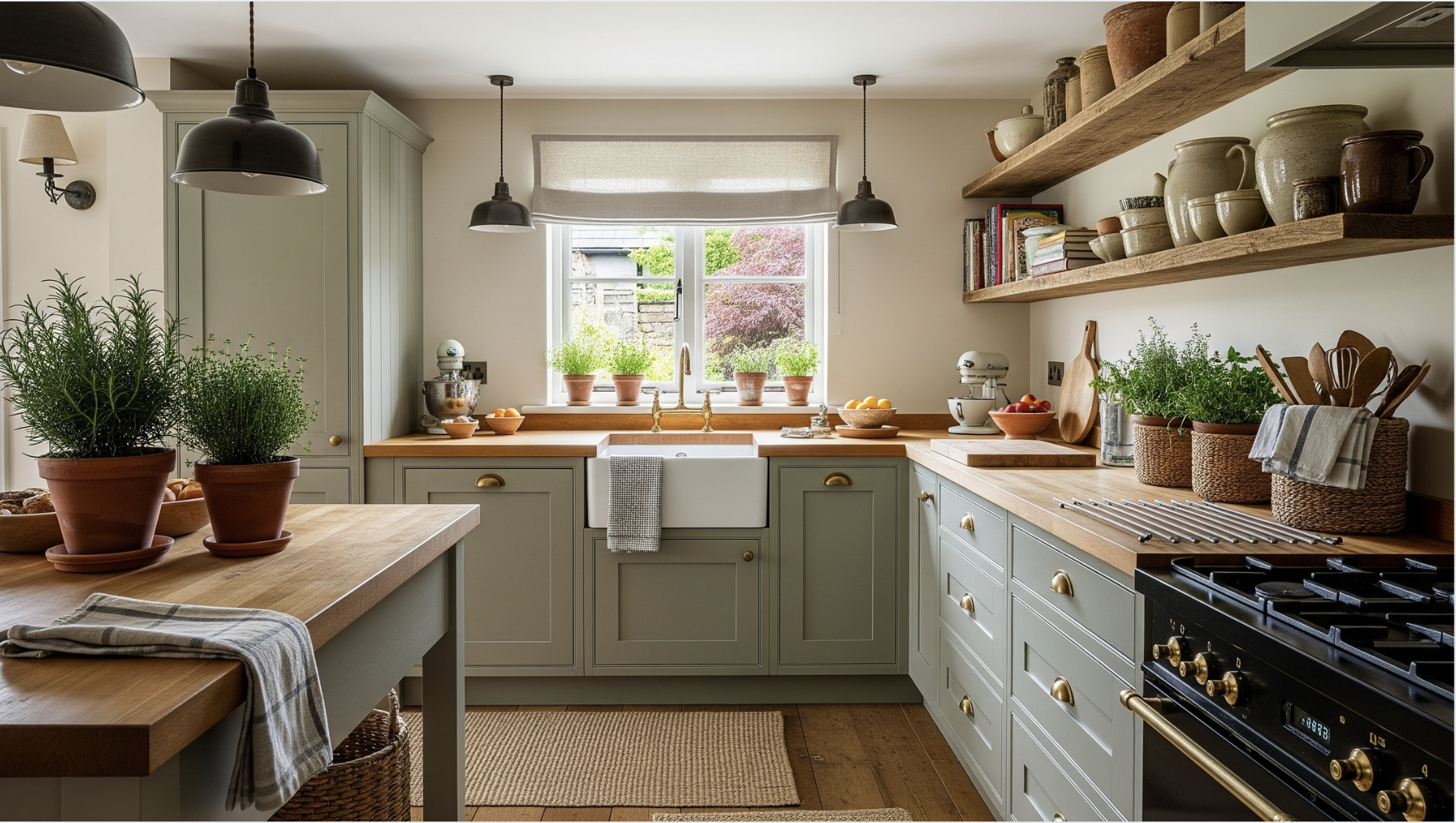I’ve always been drawn to kitchens that feel cozy, lived-in, and full of character, and rustic sage green cabinets capture that feeling beautifully.
This soft, muted green brings a calming, natural presence that works effortlessly with wood tones, aged metals, stone textures, and handmade details.
It’s a color that quietly supports everything around it while still making a statement.
I’ve gathered a variety of thoughtful ideas to inspire a warm, rustic kitchen covering materials, finishes, styling tips, and small touches that make a space feel personal.
These aren’t just surface-level trends. They’re practical, timeless choices that help turn a kitchen into the true heart of the home.
If cozy charm and natural beauty are your style, this is the perfect place to start.
Why Rustic Sage Green Cabinets Work So Well in Kitchens
Sage green is a calming color that fits perfectly with rustic designs. It adds softness while maintaining character, blending well with warm wood, aged metal, and vintage textures.
Unlike bold greens or flat neutrals, sage stands out without overpowering the room.
In kitchens, it creates a relaxed, welcoming atmosphere that feels timeless.
Paired with materials like butcher block, stone, or antique fixtures, sage green enhances the space’s charm and texture.
It’s a practical and beautiful choice for those seeking a grounded, functional kitchen filled with natural warmth.
Creative Ways to Style Rustic Sage Green Kitchen Cabinets
Sage-green cabinets bring endless styling possibilities to a kitchen, offering warmth, contrast, and a versatile base to highlight architectural details.
1. Mix Sage Green Cabinets with Reclaimed Wood Shelving

Pair your sage green cabinets with open shelving made from reclaimed barn wood. The rough texture of the wood contrasts beautifully with the soft green, creating a cozy, layered rustic look.
Display ceramic dishes, copper mugs, and vintage spice jars to enhance the farmhouse charm. The shelving opens up your space while adding character through visible storage.
You can also include personal touches, such as framed recipes or heirloom pieces. This idea works in both small kitchens and large layouts, adding vertical interest to plain walls.
Extra Tips:
- Utilize floating hardware for a clean, modern appearance.
- Add under-shelf lighting to highlight details.
2. Add Aged Brass Hardware

Install antique brass pulls, knobs, or handles on your sage green cabinetry for a timeworn, rustic feel. The golden tones of aged brass complement the muted green, adding an understated sense of luxury.
Choose rounded or weathered finishes rather than polished ones for an authentic look. Use cup pulls on drawers and simple round knobs for doors to mix styles.
This subtle update changes the entire cabinet look without requiring major changes. It’s an affordable and easy swap that instantly boosts visual warmth in your kitchen.
Extra Tips:
- Opt for unpolished or matte brass for an aged look.
- Mix knob and pull styles for variety.
3. Incorporate a Butcher Block Countertop
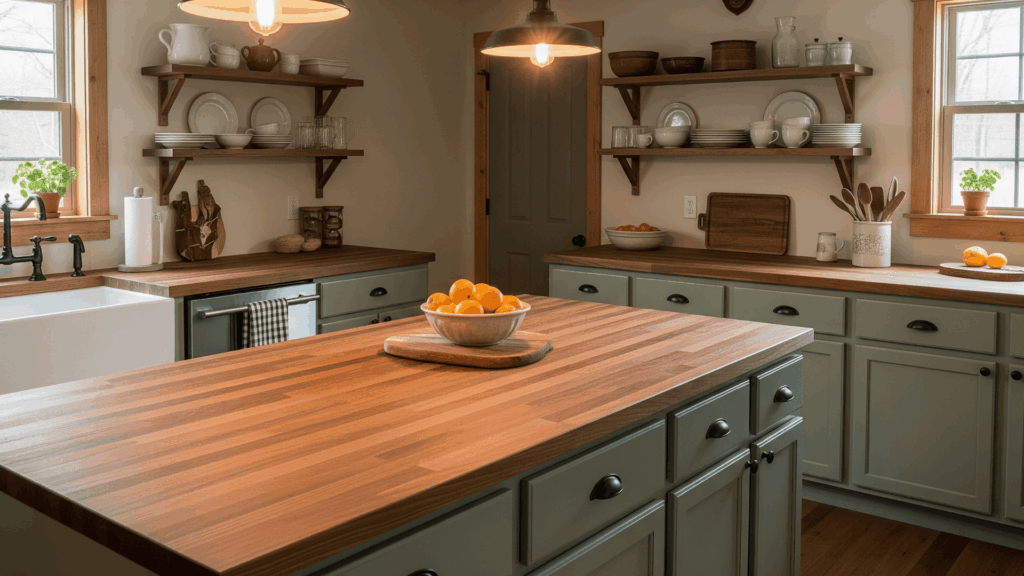
Install a thick, wood-grain butcher block countertop alongside sage green cabinets to boost rustic warmth and charm. The natural tones of walnut or oak make the sage pop and feel grounded.
Butcher blocks are practical, offering a forgiving prep surface and homey aesthetic. Keep them sealed and oiled for longevity.
The wood works particularly well in farmhouse kitchens and pairs with open shelving, black hardware, or vintage lighting. Whether for the entire counter or just an island, it’s a tactile, earthy addition that makes any kitchen feel more inviting.
Extra Tips:
- Use walnut or oak for a rich tone contrast.
- Keep the surface fresh by regularly applying oil.
4. Install Vintage-Inspired Light Fixtures

Install pendant lights or sconces with antique finishes to highlight sage cabinetry and warm up the kitchen ambiance. Choose materials like brass, bronze, or wrought iron with milk glass or seeded shades.
These lights not only provide practical illumination but also function as decorative statements. Look for lantern styles, dome fixtures, or vintage schoolhouse shapes.
Lighting over the island or sink enhances both function and aesthetics. When paired with rustic cabinets, the lighting brings cohesion and character, pulling together a timeless farmhouse or cottage kitchen look.
Extra Tips:
- Look for Edison-style bulbs for extra charm.
- Choose adjustable rods or chains for height.
5. Pair Sage Green Cabinets with White Shiplap Walls
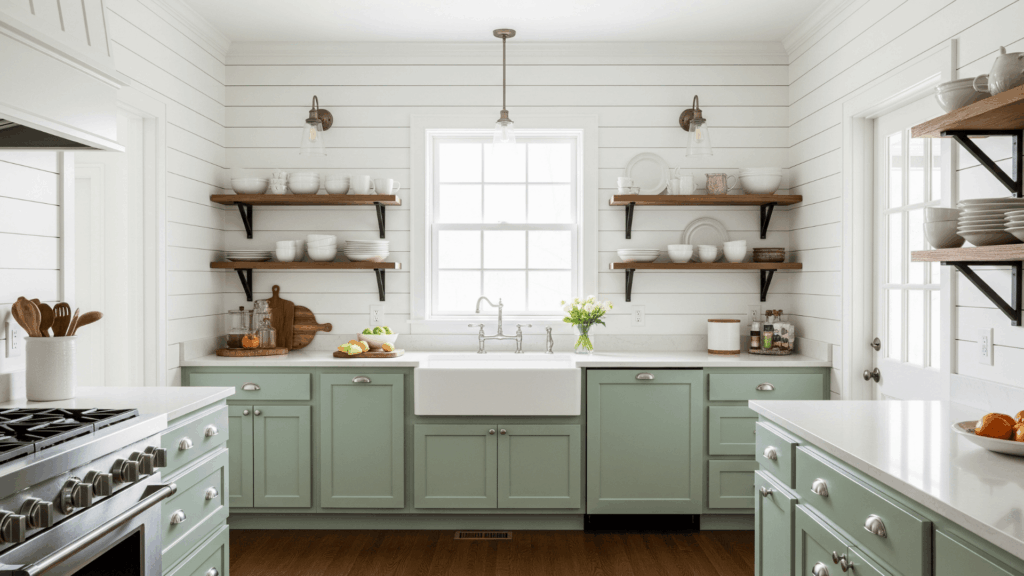
Cover your kitchen walls in horizontal or vertical white shiplap to complement sage green cabinets with a farmhouse foundation.
The clean lines of shiplap contrast nicely with soft green tones, keeping the space feeling open and bright. Use real wood or MDF boards, depending on your budget.
Shiplap also adds texture without being visually busy. It’s an excellent way to create balance, especially when paired with rustic floors, open shelving, and vintage hardware elements throughout the kitchen.
Extra Tips:
- Use real wood boards for authenticity.
- Combine vertical and horizontal panels for visual interest.
6. Use Beadboard Cabinet Panels

Switch standard cabinet fronts with beadboard paneling to enhance the rustic feel of sage green cabinetry. The vertical grooves in beadboard create texture and mimic the traditional construction of a farmhouse.
It softens the look of painted wood and adds depth without overwhelming the kitchen. Use it on both base and upper cabinets for cohesion, or just accent island fronts.
Pair it with vintage knobs or soft brass hardware for a classic look. This simple modification offers a handcrafted aesthetic and works beautifully in cottage, coastal, and country-style kitchens alike.
Extra Tips:
- Use a semi-gloss paint for durability and ease of cleaning.
- Add corner corbels for a cottage look.
7. Blend in Brick Backsplash

Introduce a brick backsplash behind your counters or stove to deepen the rustic mood around sage green cabinets. Choose classic red for warmth or a whitewashed finish for a lighter, more airy feel.
The roughness of the brick contrasts perfectly with the smooth, matte cabinetry. It adds character, charm, and visual interest, plus it’s durable and easy to maintain with the right sealant.
Brick backsplashes work especially well in farmhouse and industrial-style kitchens, grounding the space and tying in other earthy textures.
Extra Tips:
- Use faux brick panels for easier installation.
- Seal the brick for splash protection.
8. Accent with Woven Basket Storage
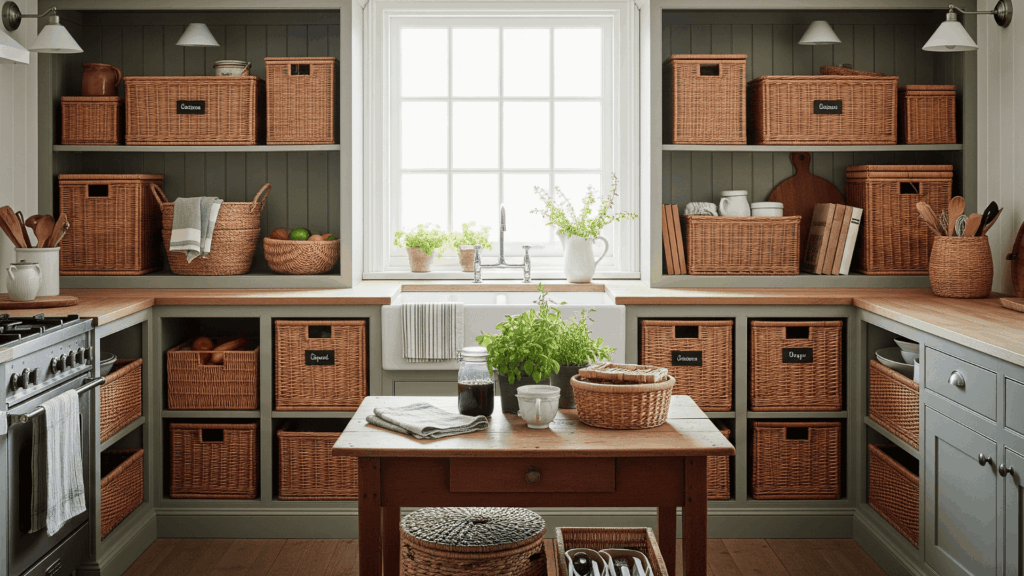
Add woven baskets to open shelving or cubbies in your kitchen to soften and complement sage green cabinets. Choose natural fiber baskets in tan or brown to introduce warm tones and an organic texture.
Use them to store produce, napkins, or utensils while keeping the space clutter-free. The combination of woven materials and muted green evokes a cottage-core or rustic countryside feel. Layer baskets of different sizes and patterns to enhance depth, and label them for a purposeful, organized look.
Extra Tips:
- Use labeled baskets for easy organization.
- Choose baskets in neutral or warm brown tones.
9. Include a Farmhouse Sink
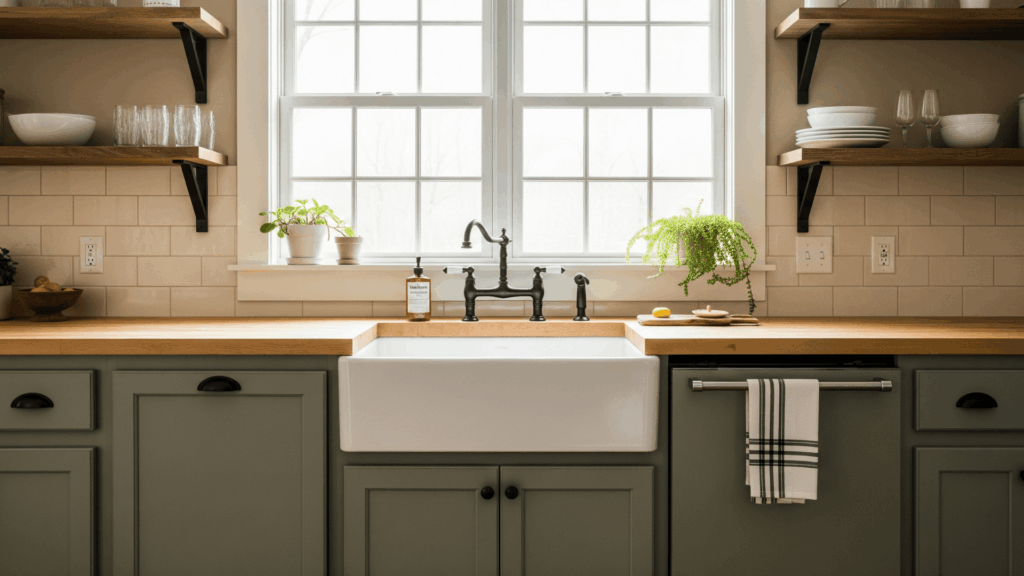
Install an apron-front farmhouse sink in white porcelain or fireclay for a standout rustic feature beneath your sage green cabinets.
Its deep basin is functional for large pots and pans, while the exposed front adds visual weight and charm. This timeless sink style pairs beautifully with vintage or matte-finish faucets.
It anchors the kitchen’s aesthetic, making your space feel curated and lived-in. Use this style in combination with butcher block counters and open shelving for a balanced farmhouse look.
Extra Tips:
- Choose a deep basin for practicality.
- Pair with a brushed bronze faucet.
10. Use Matte Sage Green Paint for a Weathered Look
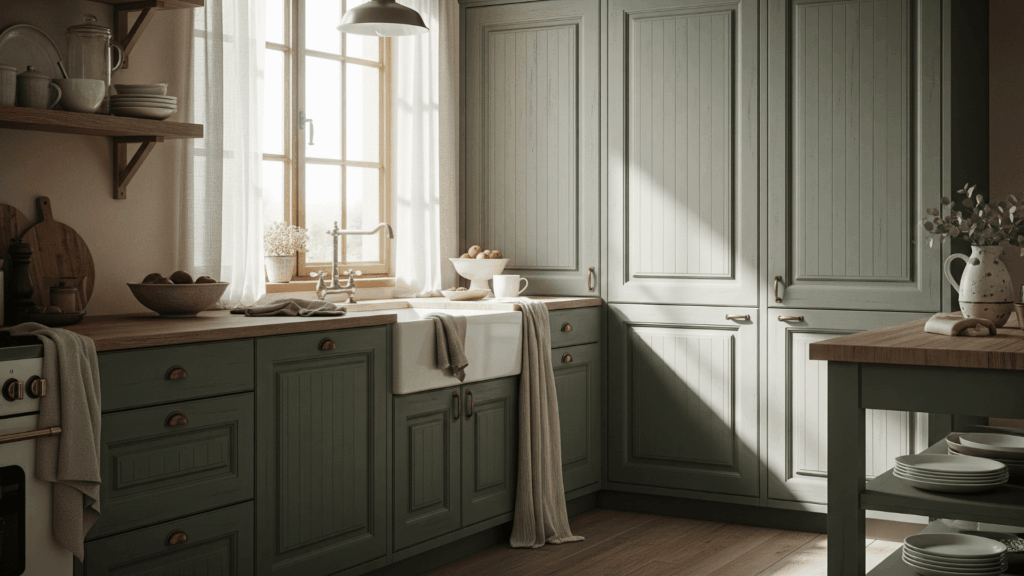
Opt for a matte finish when painting your sage green cabinets to create a naturally worn-in, vintage vibe. This texture softens the color, making it feel relaxed and authentic.
Matte paint reflects less light, which helps highlight wood grain or beadboard detailing. It’s perfect for rustic, boho, or country-style kitchens.
To increase durability, finish with a wax or flat sealant. Matte sage green also pairs well with raw wood, antique brass, and soft linen textiles, allowing the color to take center stage in a cozy, grounded way.
Extra Tips:
- Use chalk paint for an extra vintage effect.
- Top with a wax seal for protection.
11. Add Sliding Barn Cabinet Doors
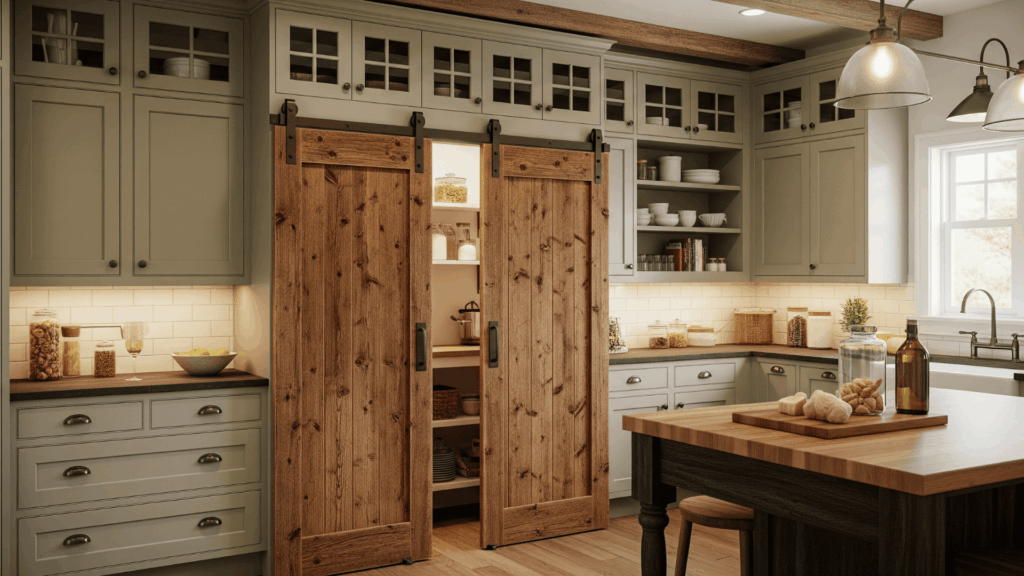
Install sliding barn-style cabinet doors on upper shelves or pantry spaces to instantly enhance the rustic appeal of sage green cabinetry.
Use reclaimed wood or lightly distressed panels to highlight texture and contrast with the soft green hue. The exposed metal track adds a utilitarian farmhouse vibe, and the sliding mechanism saves space in compact kitchens.
This approach is ideal for concealing microwave nooks or open shelving while maintaining an open and airy design. It blends function with charm effortlessly.
Extra Tips:
- Match the rail color with your cabinet hardware.
- Use distressed wood panels for added charm.
12. Pair with Soapstone Counters
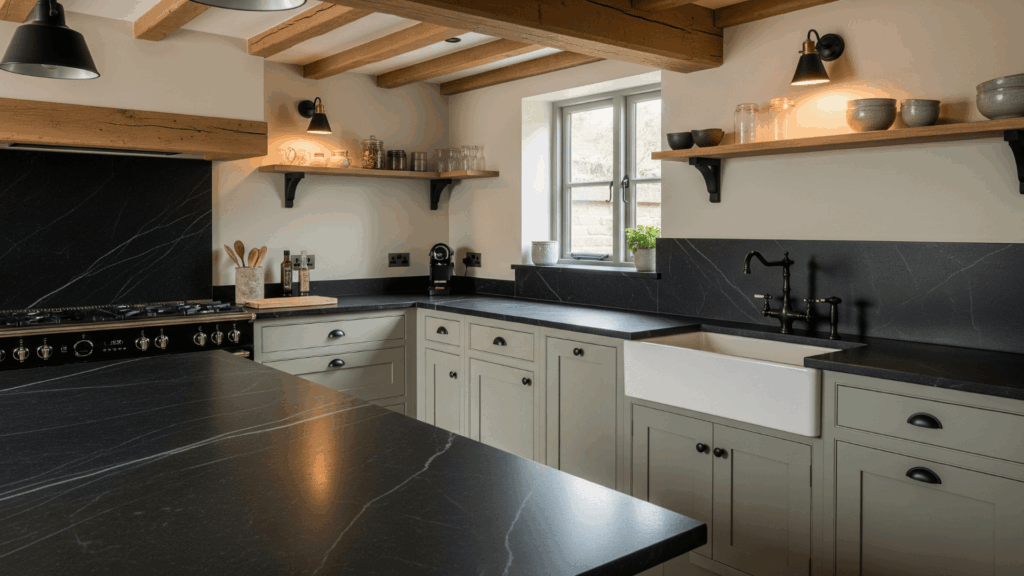
Combine sage green cabinets with soapstone countertops for a rich, organic look. Soapstone’s deep gray or black surface offers a velvety matte contrast that enhances the soft green and brings a grounded grace to rustic designs.
Soapstone is durable, heat-resistant, and ages beautifully, developing character over time. This pairing suits farmhouse, heritage, or country-modern kitchens and pairs well with wooden beams or iron hardware.
Extra Tips:
- Rub with mineral oil for a rich tone.
- Choose a matte finish for cohesion.
13. Feature a Green Kitchen Island
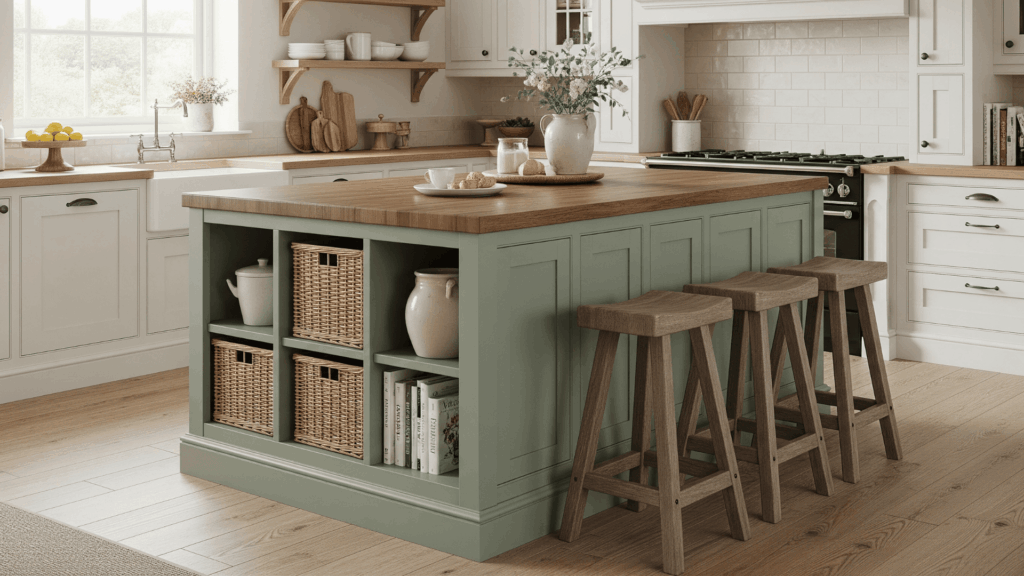
Make a sage green island the focal point by contrasting it against white or wooden cabinets. This creates a beautiful two-tone layout that adds depth to your kitchen.
The island’s soft green tone grounds the space, especially when topped with butcher block or soapstone. Add open shelves or end cubbies for baskets and cookbooks to enhance the rustic look.
This approach works well in large kitchens but can also be scaled down for smaller spaces, making the island feel like a freestanding, heirloom piece.
Extra Tips:
- Use reclaimed wood stools.
- Include built-in shelving on the island sides.
14. Combine with Vintage Tile Floors

Install vintage-inspired floor tiles such as hexagon, checkerboard, or floral encaustic designs in muted tones that complement sage-colored cabinetry.
Earthy grays, creams, or faded greens in traditional tile patterns add a heritage charm and evoke the ambiance of early farmhouse kitchens. The intricate designs on the floor ground the cabinetry and add eye-catching contrast.
Choose matte finishes for an aged effect and darker grout for easy maintenance. These floors create depth and texture underfoot while striking a balance between modern functionality and rustic warmth.
Extra Tips:
- Try encaustic cement tiles for a classic look.
- Use darker grout for low maintenance.
15. Hang-Dried Herb Bundles

Suspend bundles of rosemary, sage, thyme, or lavender above the stove, island, or window area to bring a rustic, garden-fresh feeling into your sage green kitchen.
Use hooks, rods, or reclaimed wood beams to hang herbs upside down for drying. The mix of textures and subtle natural scents creates a cozy and organic vibe.
This styling trick works especially well in open-concept kitchens where natural materials take center stage. It’s a beautiful, functional way to decorate seasonally and sustainably.
Extra Tips:
- Use natural twine and hooks for hanging.
- Dry your own herbs from the garden.
16. Use Iron or Black Metal Fixtures

Add contrast to sage green cabinets with iron or matte black fixtures throughout the kitchen. From drawer pulls and handles to light fixtures and hanging pot racks, black metals introduce a rugged edge that elevates rustic style.
They frame the soft green and provide a strong visual anchor without feeling overpowering. This combo works well in farmhouse and industrial-rustic settings.
Keep hardware solid and straightforward, or opt for vintage-inspired designs with worn finishes for added character. Repeat the color in stools or accessories for cohesion.
Extra Tips:
- Choose matte finishes over glossy.
- Repeat the black elements in stools or open shelving.
17. Decorate with Wooden Crates

Stack rustic wooden crates along the floor, under counters, or within open shelving to add functional storage and cozy texture. Choose weathered finishes or lightly stained wood to enhance the warm, natural tones against sage green cabinets.
Crates work well for storing dish towels, root vegetables, cookbooks, or jars. They also add vertical interest when used as open storage beside cabinetry or islands.
Mixing sizes or stacking them at different angles creates a relaxed, lived-in farmhouse aesthetic that feels welcoming and effortlessly rustic.
Extra Tips:
- Label crates with chalkboard signs.
- Use them to store dish towels or jars.
18. Include Chicken Wire Cabinet Inserts
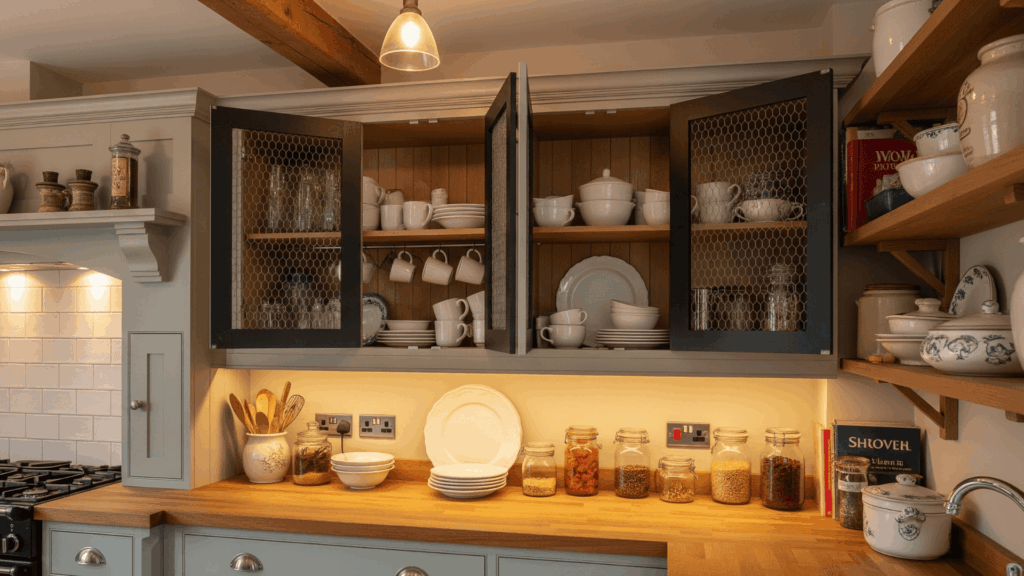
Replace select solid cabinet door panels with chicken wire inserts to give your sage green kitchen a true farmhouse feel.
The open weave allows you to display pretty dishware while keeping a soft barrier between clutter and view. Painted wire in black, bronze, or aged silver pairs beautifully with the muted green cabinetry.
This element adds instant texture and charm to upper cabinets, islands, or hutch-style cupboards. It’s an inexpensive DIY-friendly project that can convert standard doors into showpieces.
Extra Tips:
- Paint the wire black or bronze.
- Display vintage dishware inside.
19. Display Terra Cotta Pots

Line windowsills, open shelving, or countertops with small terra-cotta pots filled with herbs or flowers to bring an earthy touch to your sage-green kitchen.
The warm orange-brown tone of the clay contrasts perfectly with the coolness of sage, creating balance and organic flair.
Choose unglazed pots for a truly authentic, rustic look. Even empty pots stacked or grouped artistically can serve as charming accents. It’s a simple, affordable way to introduce garden energy into your home year-round.
Extra Tips:
- Fill pots with herbs or succulents.
- Use mismatched sizes for the charm.
20. Contrast with Natural Stone Walls
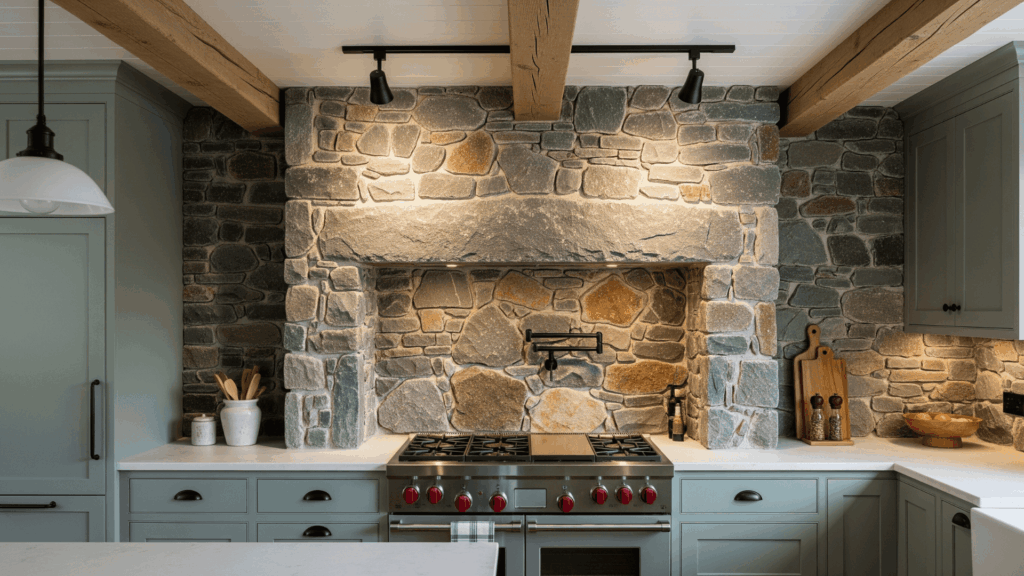
Expose or install natural stone veneer on one kitchen wall or behind the stove to enhance the earthy feel of sage green cabinets. Stone adds rich texture, weight, and timeless rustic grace to any kitchen.
Choose gray, brown, or multicolor tones depending on your cabinet shade. Irregular stones and matte surfaces are ideal for achieving an aged appearance.
This setup is perfect for creating a focal point, especially when combined with wood beams or iron fixtures. The contrast creates depth and visual grounding in the space.
Extra Tips:
- Use uneven or rough-cut stone for authenticity.
- Highlight with directional lighting.
21. Decorate with Rustic Wooden Signs
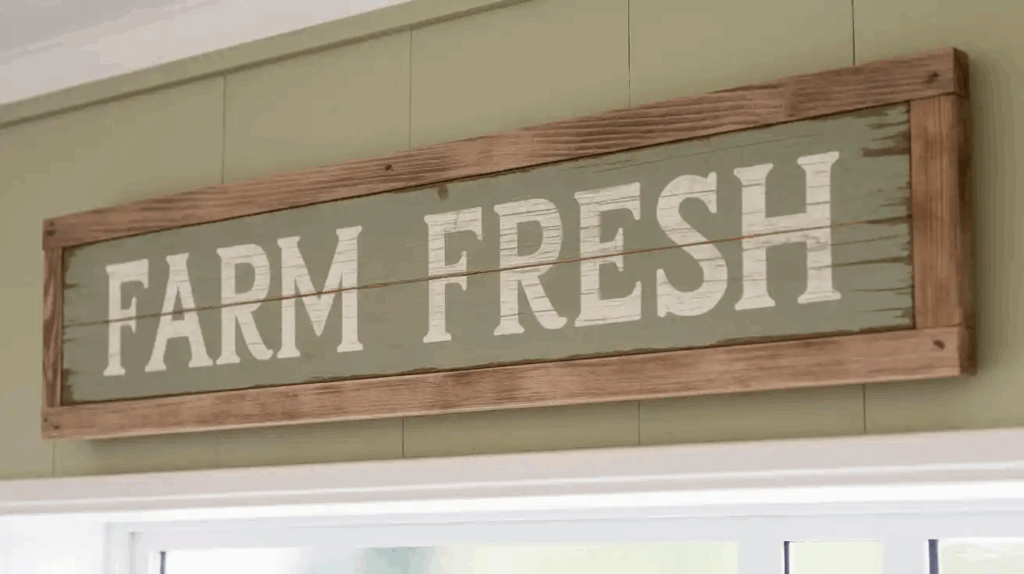
Add personality to your sage green kitchen with wooden signs featuring phrases like “Farm Fresh,” “Gather,” or “Welcome.”
Choose reclaimed or distressed wood with faded paint or hand-lettered text for that vintage charm. Hang them above windows, on open shelving, or beside the pantry door to fill blank wall space with character.
The natural grain and aged look of the signs complement sage green beautifully, reinforcing the rustic tone. Use neutral or white lettering to keep the overall palette soft and inviting.
Extra Tips:
- Use reclaimed wood for authenticity.
- Layer signs with framed art or wall baskets.
22. Layer with Jute or Braided Rugs

Add comfort and rustic texture to your sage green kitchen using jute or braided cotton rugs. Place them in front of the sink, under the island, or near the stove for softness underfoot.
Neutral tones, such as beige, tan, or muted gray, pair well with sage and maintain a cozy, grounded look. Choose oval or round shapes for vintage appeal.
These rugs incorporate natural fibers that enhance the farmhouse vibe without detracting from your cabinetry.
Extra Tips:
- Look for washable options.
- Stick to low-pile rugs to avoid slipping.
23. Add Window Valances in Gingham or Linen
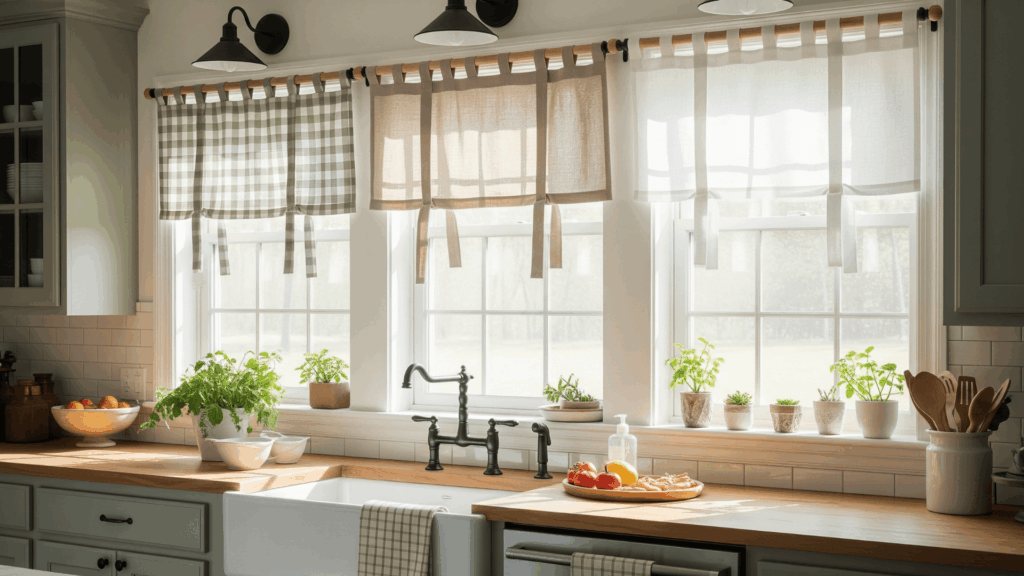
Dress your kitchen windows with simple valances made of gingham or linen to soften the space and enhance rustic charm. Choose light fabrics in warm whites, beiges, or sage-adjacent hues.
Gingham patterns add a country flair, while solid linens maintain a minimalist and fresh aesthetic. Mount valances just above the window frame using black iron or natural wood rods.
These soft textiles warm the room without overpowering the sage cabinets or blocking natural light.
Extra Tips:
- Use wooden or black iron curtain rods.
- Avoid heavy drapes and keep it light.
24. Install a Plate Rack Over the Counter
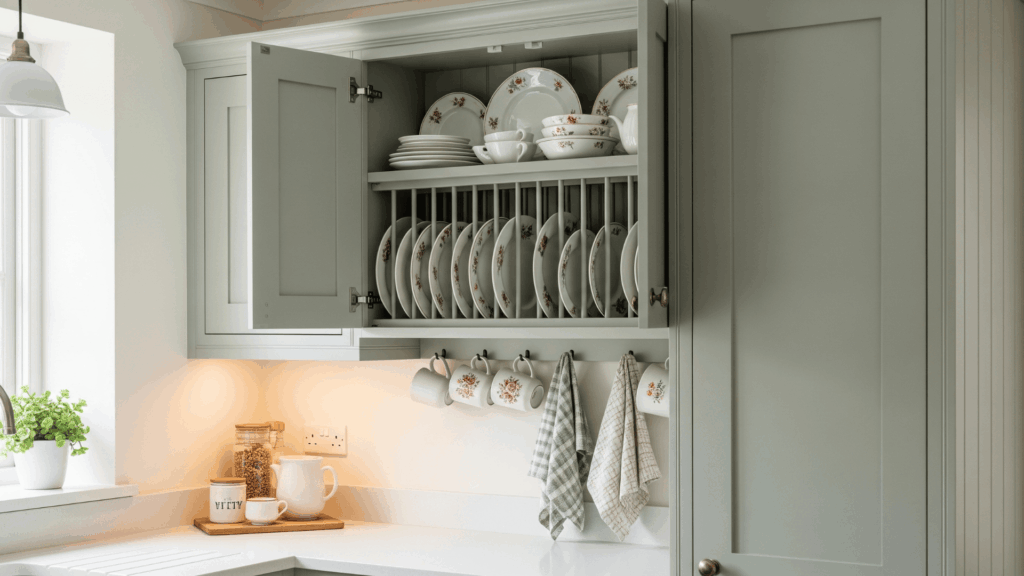
Add a custom plate rack painted to match your sage green cabinets for a functional and stylish rustic feature.
Mounted above a counter or within an open cabinet space, this rack offers quick access to dishes while creating a curated look.
Displaying white or floral plates enhances the contrast and adds a vintage appeal. Include hooks beneath for hanging mugs or linens. This idea keeps things visually interesting and helps break up solid cabinet lines with practical open storage.
Extra Tips:
- Use white or floral plates for contrast.
- Add hooks below for mugs.
25. Display Rustic Cutting Boards Upright

Place chunky wooden cutting boards upright along your backsplash or leaned against the wall to add warmth and layering. Select boards in various shapes, grains, and stains, especially aged or handmade styles, to complement sage green cabinetry.
This look gives a rustic, lived-in feel and brings natural contrast to green paint. It’s also functional, making cutting boards easy to grab. Add ceramic crocks, mason jars, or herb pots nearby to complete the cozy countertop styling.
Extra Tips:
- Oil your boards to prevent them from drying out.
- Use real wood, not bamboo, for a richer tone.
26. Use Mason Jars for Open Storage
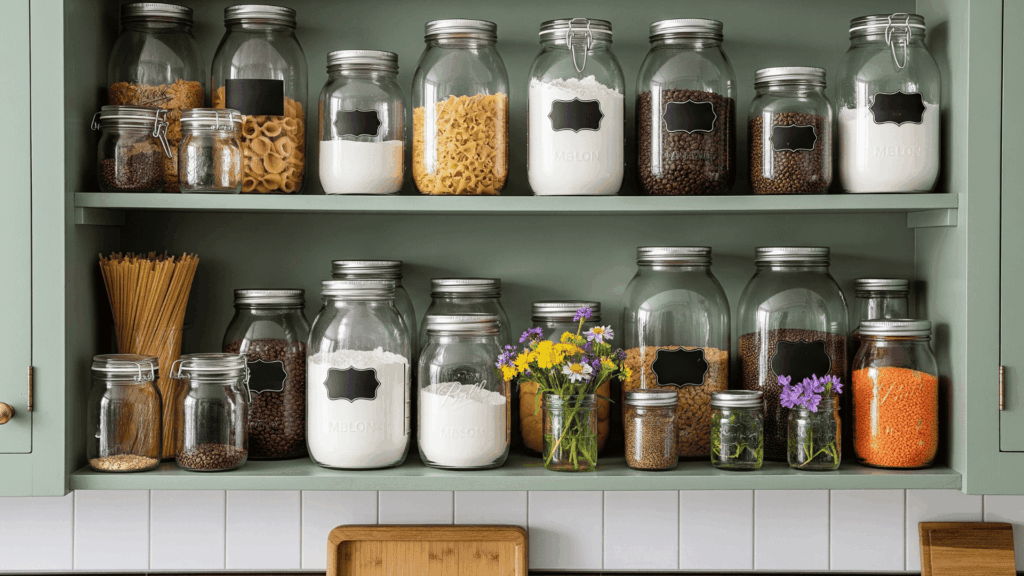
Incorporate clear mason jars into your kitchen for practical and decorative storage that complements rustic, sage-green cabinets.
Fill them with dry goods like flour, pasta, lentils, or coffee beans, and place them on open shelves or countertops. Their transparency and vintage lids add old-fashioned charm without clutter.
You can also use smaller jars for spices, dried herbs, or even flowers. The clean glass contrasts nicely with the muted green tones, giving your kitchen a tidy, well-loved, and purposeful appearance.
Extra Tips:
- Label jars with chalkboard tags or stencils.
- Choose wide-mouth jars for easier use.
27. Try Green-on-Green with Two Shades
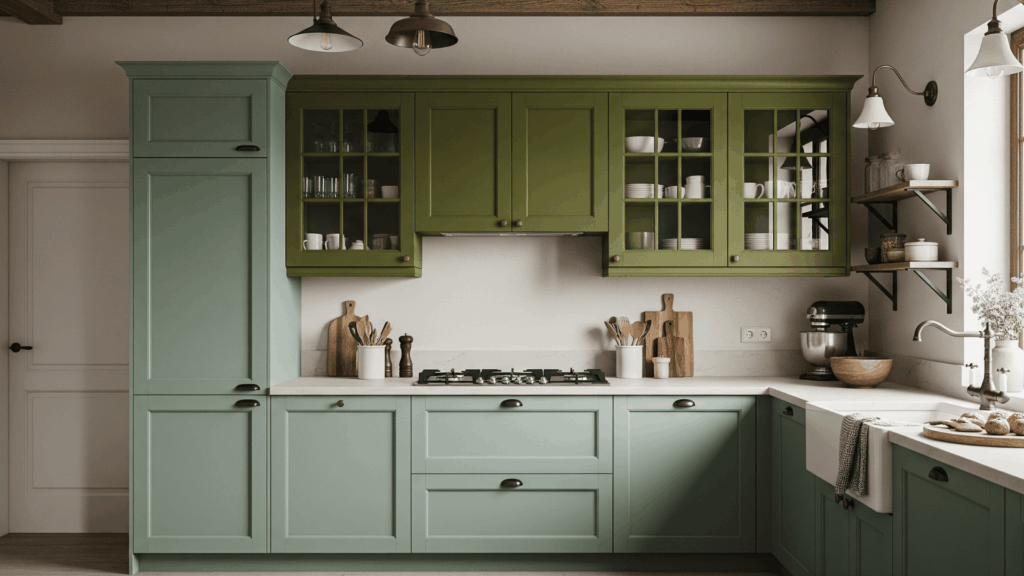
Layer two tones of green for a unique and cozy kitchen: sage for lower cabinets and a deeper moss or olive shade for uppers.
This tonal approach creates subtle depth, helping the space feel grounded and natural. It works especially well in larger kitchens with high ceilings or lots of natural light.
Keep wall color and countertops light to avoid overpowering the space. Unifying the look with consistent hardware and accents helps tie everything together for a seamless rustic feel.
Extra Tips:
- Keep walls neutral to avoid color overload.
- Choose consistent hardware to unify both tones.
28. Highlight Cabinet Feet with Distressed Trim
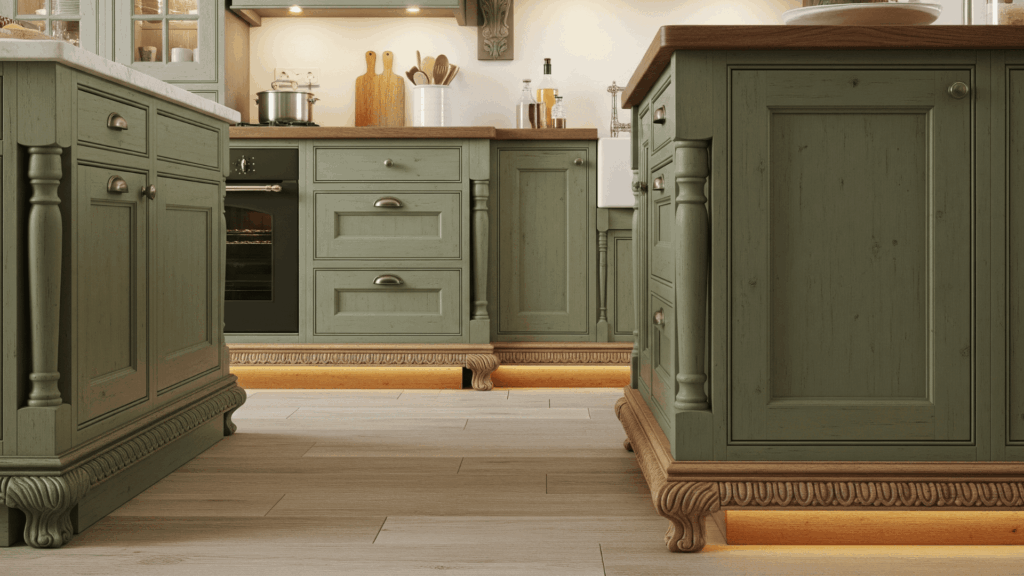
Add carved wood feet or apron molding to the base of your sage green cabinets to create a built-in furniture look. Choose distressed or stained wood for a more rustic, handcrafted effect.
This detail adds charm to your kitchen and remakes ordinary cabinetry into standout pieces. It’s particularly striking on islands or corner cabinets and can be painted in a matching sage or contrasting color.
A small touch like this brings warmth, texture, and personality to any rustic kitchen layout.
Extra Tips:
- Use a darker glaze over the paint to age it.
- Choose chunky styles over sleek.
29. Incorporate Raw Wood Ceiling Beams
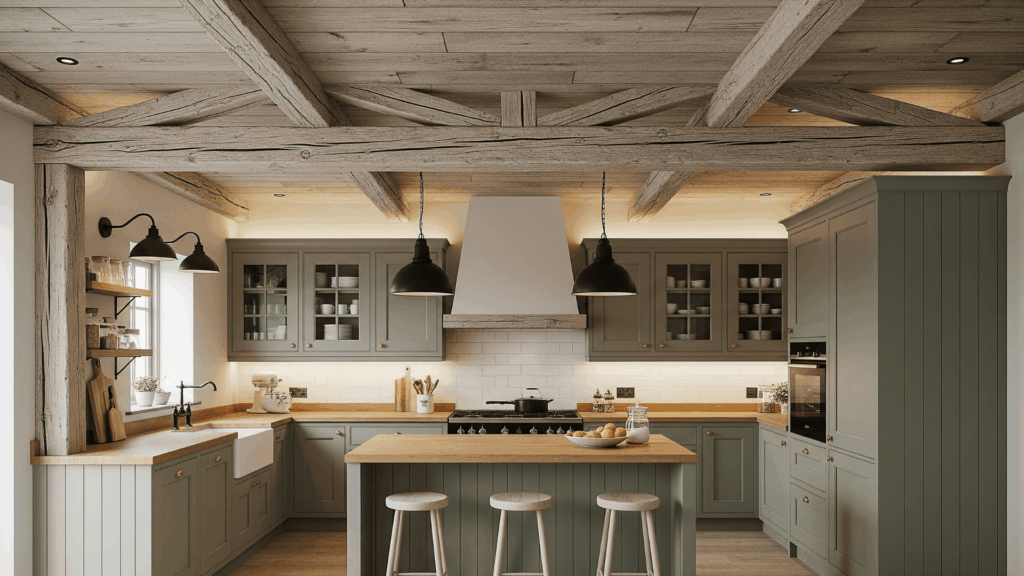
Expose or add faux wood ceiling beams to elevate your rustic kitchen with architectural interest. The natural wood grain draws the eye upward and adds warmth, contrasting with the sage green cabinetry.
Whether stained dark or left light and weathered, beams add depth and a cozy, barn-style atmosphere. They work beautifully in both vaulted and flat ceilings.
Combine with iron light fixtures, butcher block surfaces, or vintage stools to complete the rustic farmhouse feel throughout the room.
Extra Tips:
- Use pine or cedar for a lighter contrast.
- Seal beams to prevent warping over time.
30. Paint Lower Cabinets Only
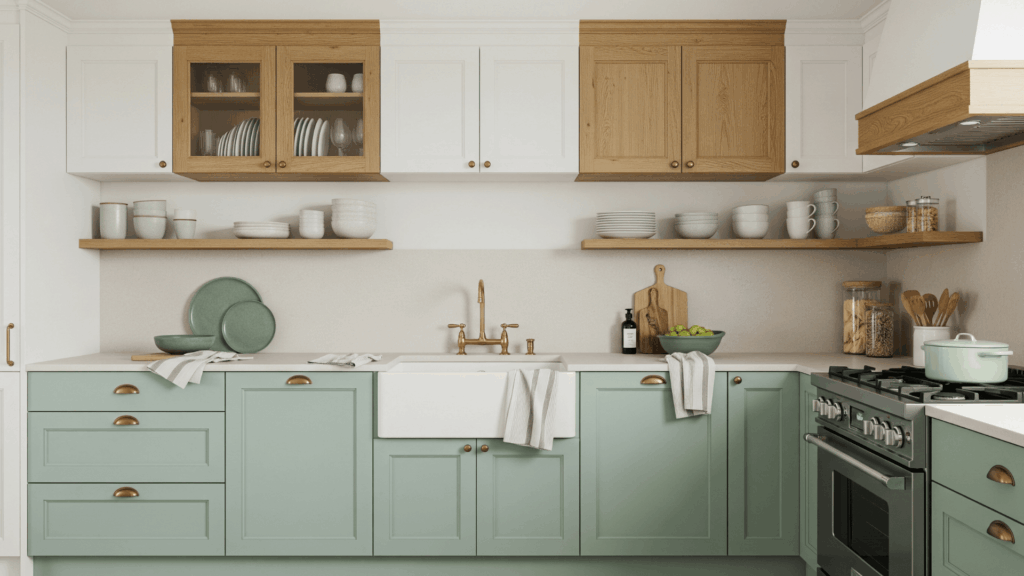
Limit sage green paint to your base cabinets while leaving the uppers white or natural wood for a lighter, airier design. This approach works especially well in smaller kitchens, as it adds warmth and color without making the space feel closed in.
The two-tone cabinetry trend also allows you to showcase sage green without overwhelming the entire room. Choose complementary tones for walls, hardware, and tile.
Extra Tips:
- Use a crisp white like “Chantilly Lace.”
- Balance with green accents like dishware or linens.
31. Use Distressed Glass in Cabinet Doors

Swap solid cabinet doors with seeded, frosted, or rippled glass inserts for a rustic, handmade touch. These glass textures soften the look of sage green cabinetry, evoking an old-world charm while still offering partial concealment of interior contents.
The subtle light diffusion adds depth, especially in small kitchens. Pairing with soft cabinet lighting behind the glass enhances the rustic feel.
It’s a subtle way to break up solid blocks of green while maintaining function and vintage style.
Extra Tips:
- Choose antique-style pulls to match.
- Backlight the cabinet interior for a glow.
32. Add an Antique Pot Rack
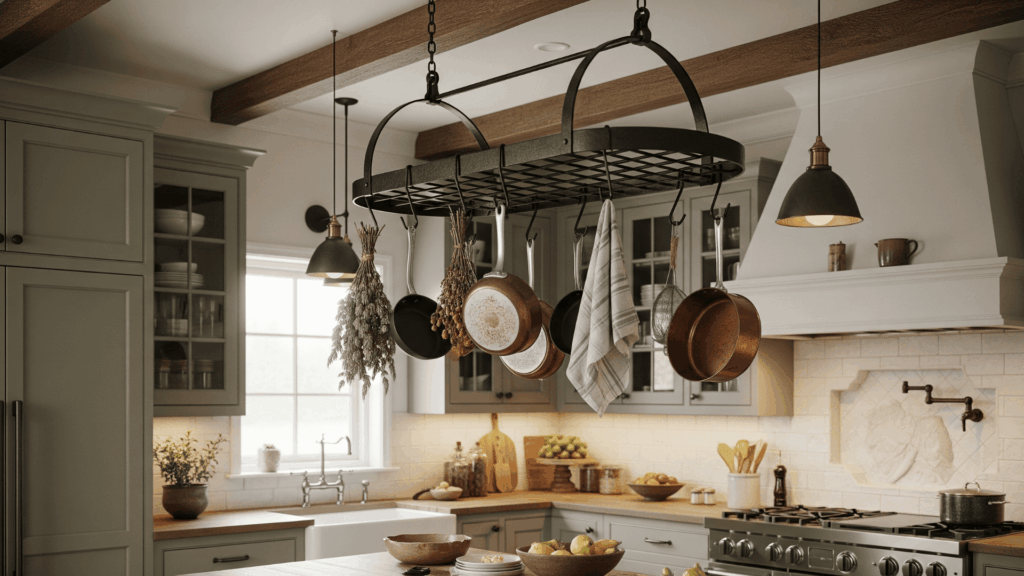
Hang a ceiling-mounted pot rack over your stove or island to display cast iron or copper cookware. This instantly brings a rustic flair to sage green cabinetry and emphasizes utility-based décor.
A pot rack not only maximizes space but creates a lived-in feel, especially when layered with dried herbs or kitchen towels. Choose one with curved ironwork or wooden beams for a farmhouse-inspired look.
This works great in both open-concept and galley kitchens, where ceiling space is often underutilized.
Extra Tips:
- Use black or wrought iron hardware.
- Add herbs or dried flowers to soften the look.
33. Incorporate an Arched Range Hood
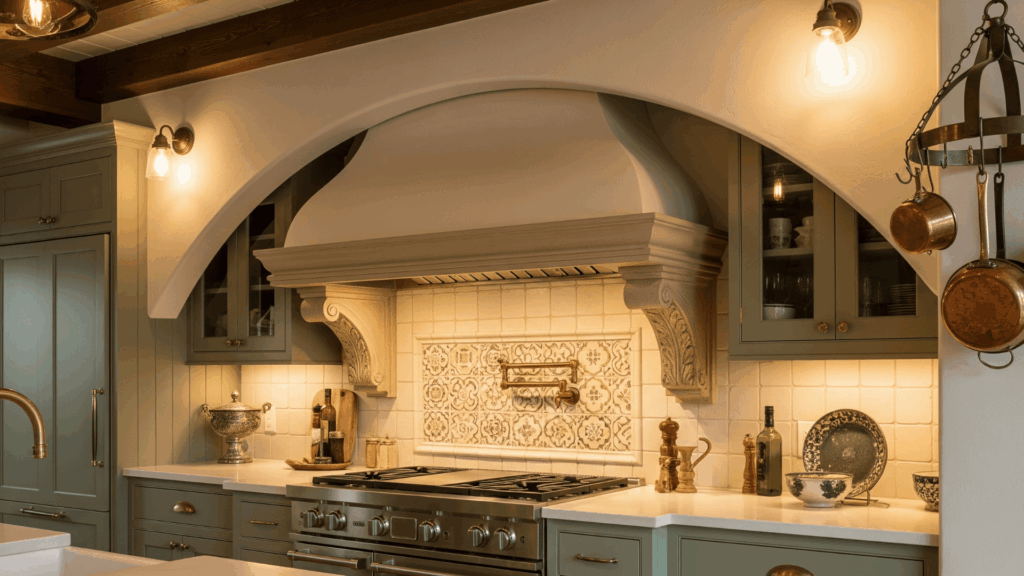
Create a cozy focal point by installing a curved or arched range hood above your cooktop. Whether wood-wrapped, plaster-finished, or left in natural tones, the arch plays beautifully off sage green cabinets and adds old-world character.
Consider painting the hood in a soft cream or beige to create a gentle contrast, or leave it in unfinished oak for a natural match. Add tile detailing or subtle corbels for an extra touch of flair.
This soft architectural curve invites charm and balance to your rustic space.
Extra Tips:
- Use stone or tile detail under the hood.
- Add carved corbels for detail.
34. Decorate with Enamelware Accents
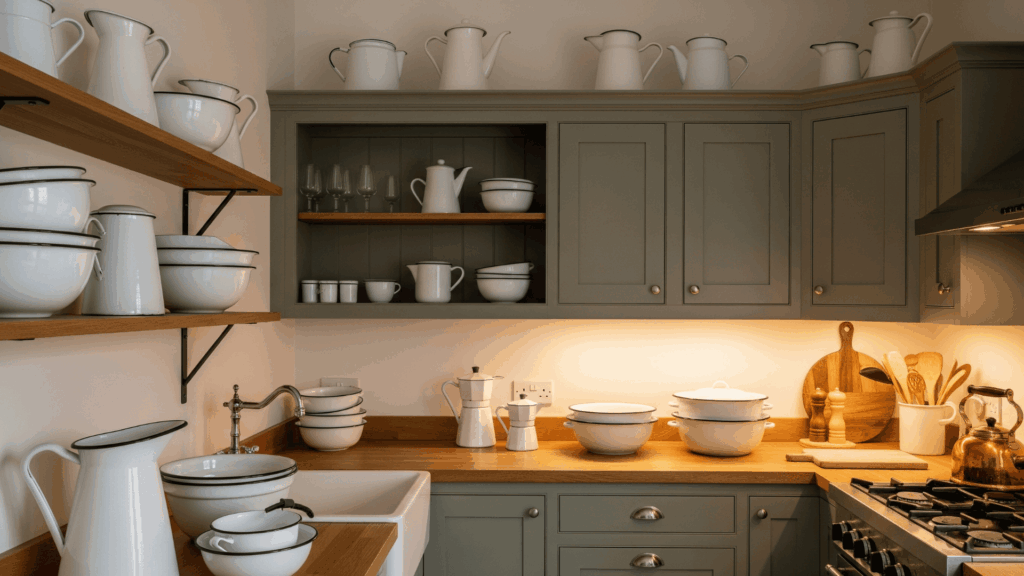
Use vintage enamelware pieces, such as white pitchers, coffee pots, or mixing bowls with black trim, to bring farmhouse character to your sage green cabinetry.
Display them on open shelving, countertops, or atop cabinets for visual interest. These pieces add a pop of contrast without overpowering the soft green tone.
Their nostalgic charm complements rustic or cottage-style kitchens perfectly. Even a few authentic items or replicas can tie together your color scheme and add texture to your kitchen layout.
Extra Tips:
- Display on open shelves or countertops.
- Look for vintage pieces at flea markets.
35. Frame the Window with Natural Wood Trim
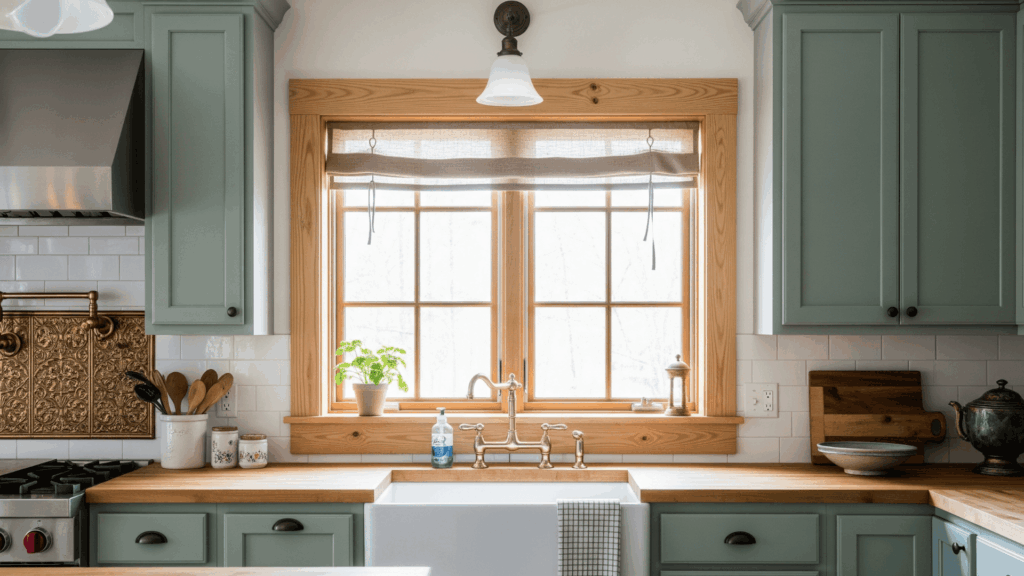
Accent your kitchen window with a simple frame in raw or lightly stained wood. This natural element balances the cooler hue of sage green cabinets, bringing warmth to the space.
It’s especially effective in kitchens that lack other wooden components, such as beams or floors. A natural wood trim instantly grounds the room, giving it a handcrafted, rustic vibe.
Keep it minimal or add a subtle detail for extra charm. Pair it with neutral fabric valances or leave it bare.
Extra Tips:
- Match trim wood to butcher block or beams.
- Use satin finish for a natural sheen.
36. Accent with Wrought Iron Bar Stools
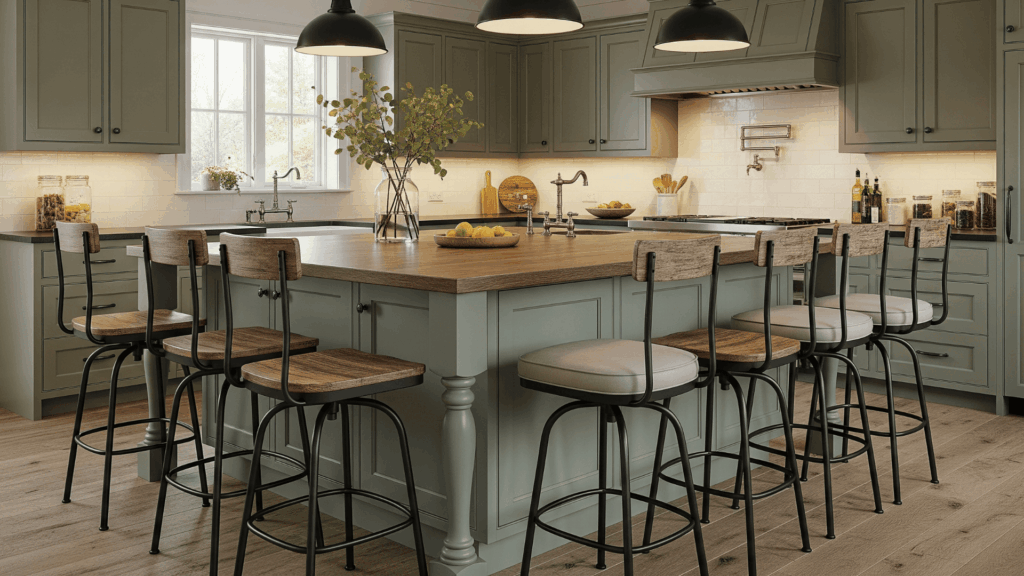
Add a rustic edge to your sage green kitchen by using wrought iron or black metal bar stools with warm wood seats. These sturdy stools bring industrial farmhouse character while complementing the softness of sage cabinetry.
Use them around a kitchen island or breakfast nook. The contrast in material makes both the iron and green pop visually.
Choose distressed wood seats or leather pads for comfort and a lived-in look. This idea works well in both small and large kitchens.
Extra Tips:
- Cushion with neutral fabric or faux leather.
- Use low-back or backless styles in small spaces.
37. Create a Pantry Nook with Sage Cabinets

Change one wall of your kitchen into a built-in pantry using sage green cabinetry. Incorporate tall storage units, open shelving, and cubbies for jars, baskets, and dry goods.
This layout adds tons of function and gives off an old-time general store feel. Painted in sage green, it blends perfectly into the rest of your rustic kitchen and becomes a focal point.
Use black hardware and natural wood accents to complete the look, keeping the space grounded and warm.
Extra Tips:
- Label shelves with chalk signs.
- Display glass jars, tins, and baskets.
38. Use Terracotta or Clay Floor Tiles
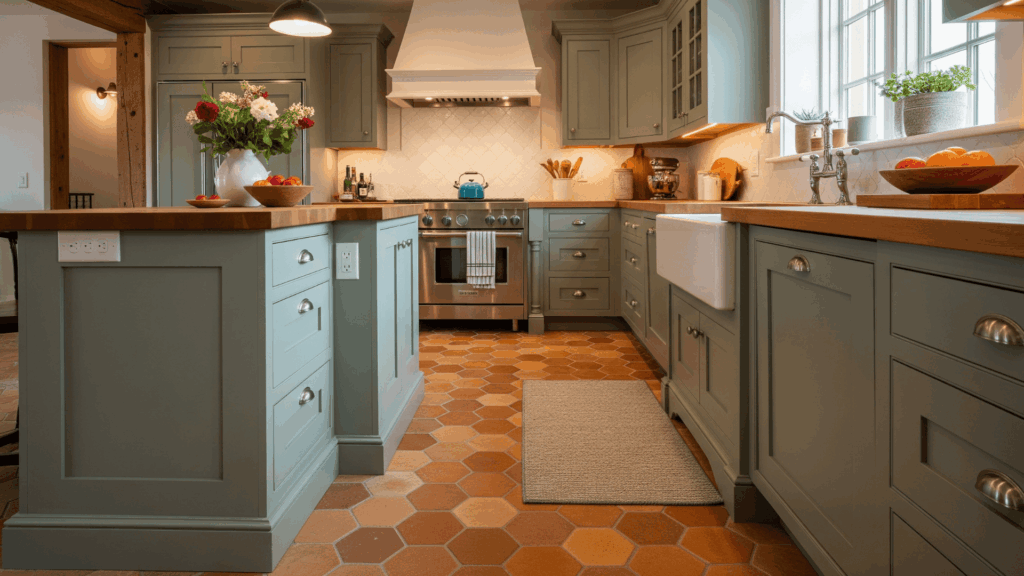
Install terracotta or handmade clay tiles in patterns like herringbone or hexagon to add warmth underfoot and contrast with your sage cabinets.
The orange and red undertones of the tile create a perfect earth-toned balance with green cabinetry. Choose unglazed or matte finishes to maintain a rustic and natural look.
These floors feel grounded and pair especially well with other natural elements, such as butcher block countertops or exposed beams. Add a small runner for comfort and subtle color layering.
Extra Tips:
- Seal tiles to prevent staining.
- Add a small wool runner for softness.
39. Mix in Vintage Appliances
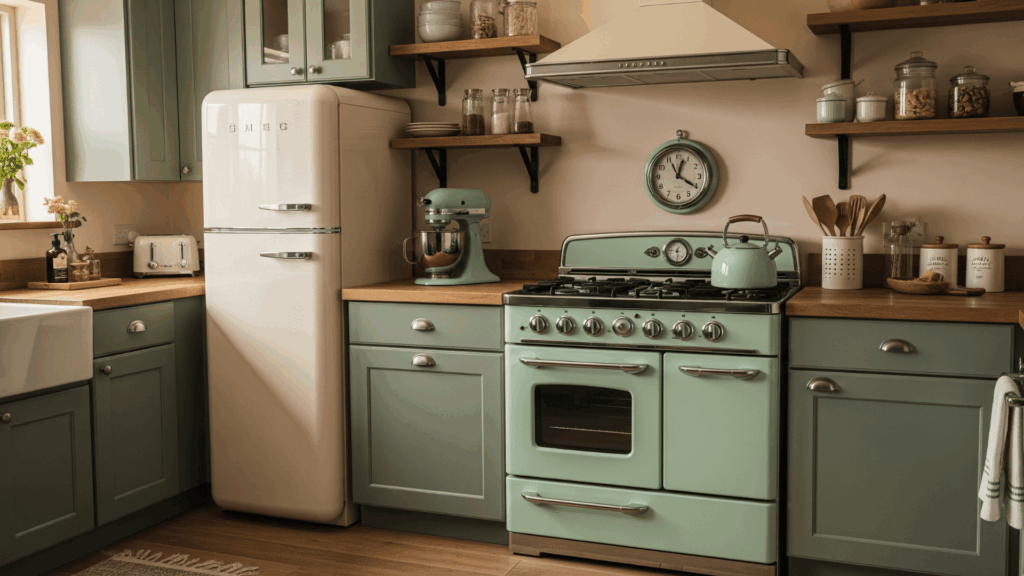
Choose retro-inspired appliances in cream, off-white, or muted green to complement rustic sage cabinetry. These appliances add personality and nostalgia, reinforcing the country kitchen feel.
Whether it’s a vintage-style fridge, a 1950s-inspired stove, or even a pastel stand mixer, they create a cohesive look.
Opt for rounded edges, chrome accents, and large dials. If you prefer a budget route, try peel-and-stick decals or appliance paint to mimic the look of these stylish statement pieces.
Extra Tips:
- Brands like Smeg or Big Chill offer vintage looks.
- Match knobs or handles to cabinet hardware.
40. Try a Chalkboard Pantry Door
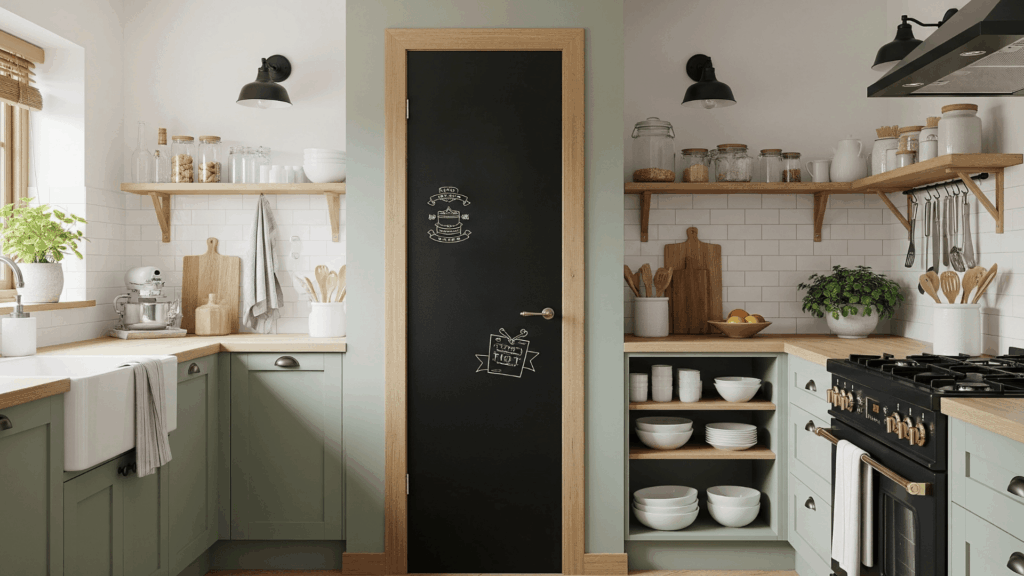
Turn your pantry or a side cabinet door into a functional chalkboard. Paint it black and frame it in rustic wood or keep the edge soft for a cleaner look. Use it for handwritten menus, reminders, or seasonal greetings.
Against sage green cabinetry, the matte black board adds depth and visual interest while serving a practical purpose. This is a small project with a big payoff in character.
Perfect for families or rustic kitchens that lean playful and lived-in.
Extra Tips:
- Write weekly menus or grocery lists.
- Frame it with natural wood for a finished look.
41. Add Decorative Corbels Under Cabinets
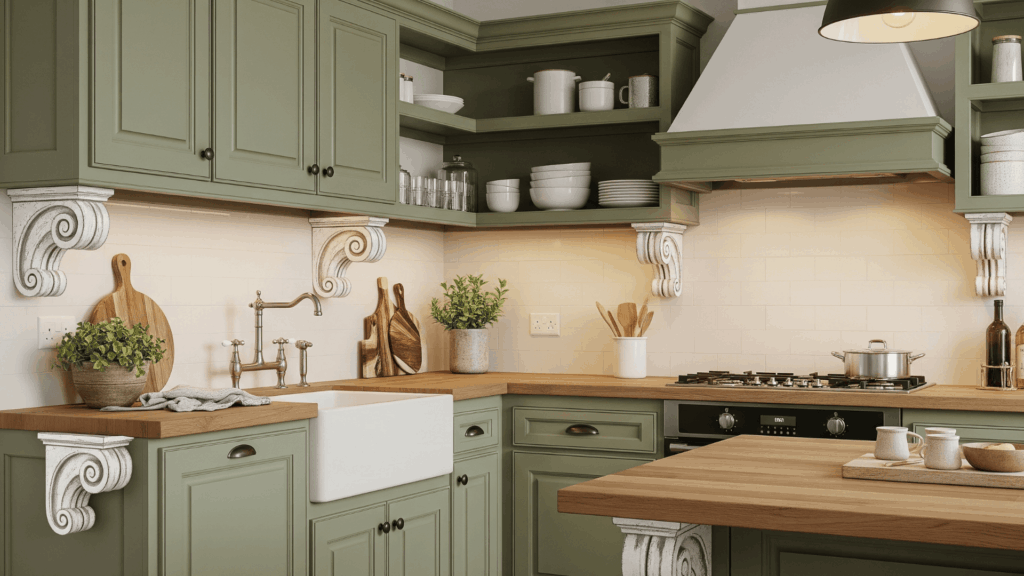
Mount carved wood corbels beneath upper cabinets, shelves, or hood areas to add a timeless, handcrafted detail to your sage green kitchen.
These small additions create the appearance of custom furniture and enhance the rustic authenticity. Choose chunky or scroll-shaped styles in distressed or painted finishes.
They draw the eye and make cabinetry feel more substantial. Best used in corners, island overhangs, or to support open shelving visually.
Extra Tips:
- Paint corbels in the same sage shade or distress with white.
- Use large, ornate designs for dramatic effect.
42. Hang a Rustic Clock on the Wall

Add a large, wooden or metal-framed clock to an empty wall or above a doorway. The worn textures and oversized dials complement the casual classiness of sage green cabinets.
Choose Roman numerals and a neutral tone that won’t compete with the cabinets. This single piece acts as both décor and utility, tying together farmhouse or rustic elements with a time-honored charm.
You can even find upcycled clock styles using pallet wood or galvanized materials.
Extra Tips:
- Select Roman numerals for a classic, antique feel.
- Hang above a doorway or near the dining area.
43. Pair with Creamy Off-White Walls

Surround sage green cabinets with soft, warm white walls to create a rustic kitchen that feels light, welcoming, and balanced. Choose whites with yellow, beige, or taupe undertones for harmony rather than stark contrast.
This approach works well in kitchens with limited natural light, as it brightens the space without looking sterile.
A creamy background allows the sage green cabinetry to remain the star, while maintaining a timeless, rustic look that won’t go out of style.
Extra Tips:
- Try colors like “Swiss Coffee” or “Alabaster.”
- Avoid stark white, which can feel too modern.
44. Style with Ironstone Dishware

Display white ironstone serving pieces, such as pitchers, cake stands, or soup tureens, on open shelves, hutches, or glass-front cabinets.
Their creamy tone pops beautifully against sage green cabinetry and adds a collected, vintage vibe. Look for pieces with subtle curves, embossed details, or aging marks for added charm.
Even a few well-placed pieces will create a farmhouse aesthetic and support the color palette without adding clutter or contrast that’s too bold.
Extra Tips:
- Layer plates for a fuller display.
- Shop thrift stores for unique pieces.
45. Incorporate a Wood-Framed Message Board
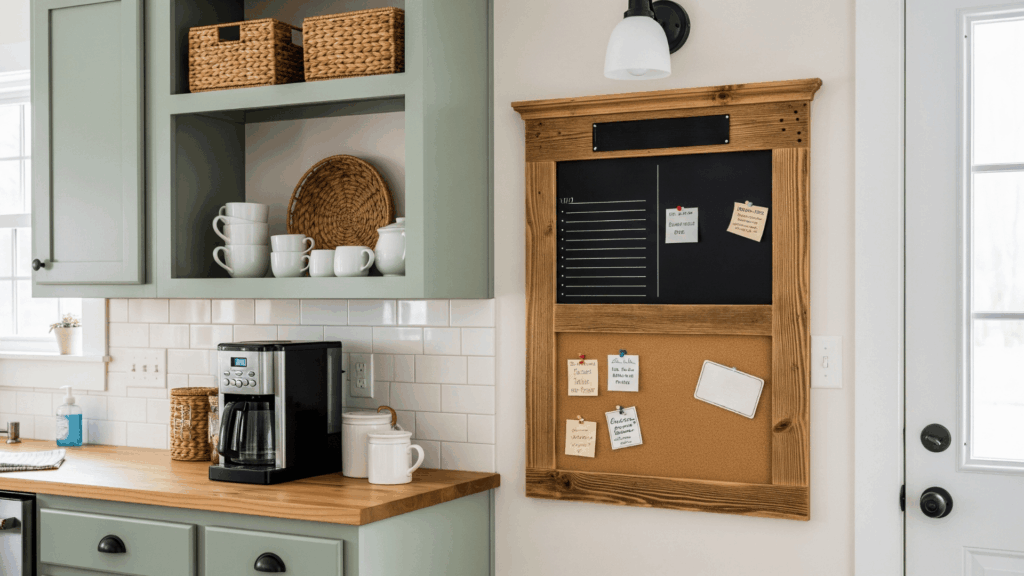
Mount a message board framed in natural or distressed wood near your entry, pantry, or coffee station. Whether cork or chalkboard, it brings a functional and decorative layer to your rustic sage green kitchen.
Use it to post grocery lists, meal plans, or even seasonal greetings. The mix of wood grain and sage green cabinetry gives the space a relaxed, lived-in look. It’s a small but charming way to keep your kitchen warm and personal.
Extra Tips:
- Rotate messages seasonally.
- Use vintage-style thumbtacks or chalk markers.
Final Thoughts
If you’re anything like me, you want a kitchen that feels beautiful, functional, and full of heart, and rustic sage green cabinets are the perfect way to achieve that.
Rustic sage green cabinets bring together warmth, charm, and practicality in a way few colors can.
Even if you’re just swapping out hardware or planning a full kitchen remodel, this soft, earthy green offers a timeless base to build from.
There’s something special about the calmness of sage green mixed with cozy, rustic charm; it just works.
If you found this blog helpful or inspiring, share it with a friend, save your favorite ideas, or pass it along to someone planning a kitchen update.

